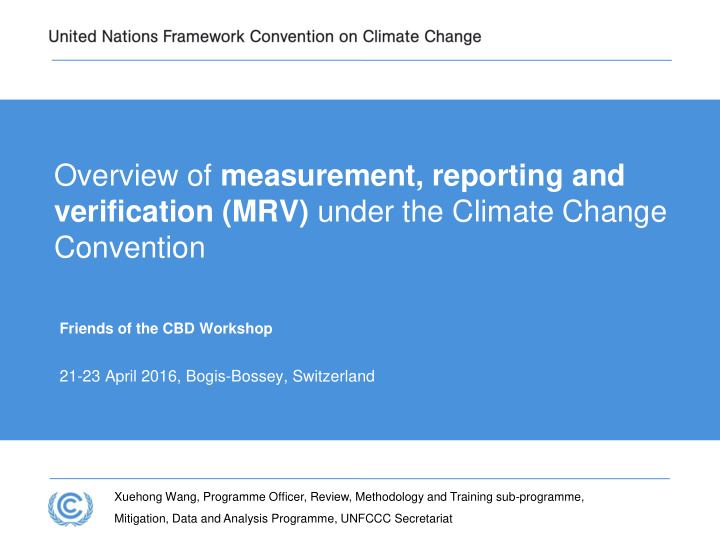



Overview of measurement, reporting and verification (MRV) under the Climate Change Convention Friends of the CBD Workshop 21-23 April 2016, Bogis-Bossey, Switzerland Xuehong Wang, Programme Officer, Review, Methodology and Training sub-programme, Mitigation, Data and Analysis Programme, UNFCCC Secretariat
Outline of Presentation Overview of the MRV system under UNFCCC Impacts of MRV Resource implications Challenges
Existing MRV under the UNFCCC A system to track the implementation of the Convention (progress in achieving emission reduction target under the Convention and KP) and to identify capacity- building needs of Parties Measurement • Emissions and removals of GHGs (M): guided by • Effectiveness of policies and measures IPCC guidelines and methods • GHG inventories Reporting (R): • Other aspects of implementation (mitigation and guided by reporting adaptation actions, GHG projections, financial, guidelines technology transfer and capacity building support, etc.) • Technical review/ analysis Verification (V): • Compliance assessment for KP Parties guided by review • Multilateral consideration process under the International guidelines/ Assessment and Review (IAR) and International modalities and Consultation and Analysis (ICA) processes, commenced procedures in 2014
Frequency of MRV Color coding Convention only Kyoto Protocol only Both Convention and Kyoto Protocol
MRV under the Paris Agreement • Submission of nationally determined contributions (NDCs) by all Parties and global stock take • Reporting by/ review and multilateral consideration of each Party on a biennial basis (with the exception of LDCs and SIDS) a) Progress with the implementation of NDCs b) Progress with the provision/ receipt of support c) Identification of capacity building needs • Non- backsliding principle: annual reporting and review continues • Outcome of the MRV as inputs to global stock take (aggregate progress) • Submission of NDCs could be a separate process
Impacts of MRV • Enhance transparency and accountability of Parties’ climate action and support & build trust and confidence among Parties a) Track progress of implementation and assess compliance (for KP Parties) b) Inform the 2013 -2015 review (existing) c) Inform global stock take (under the Paris Agreement) • Improve Parties’ reporting overtime and build capacities • Share best practices in climate action and support
Resource implications of the process Secretariat Coordination of reviews • Provision of review officers • Operational support: IT and non-IT tools • Training of review experts Main subject of MRV Parties • Compilation of reports • Hosting in-country reviews and internal coordination • Nomination and provision of review experts Review experts Perform reviews • Time and resources to perform reviews and drafting review reports • Participation in training activities SBI Platform for multilateral consideration • Time allocated during the session for the multilateral consideration process
An example of one IAR cycle • Annual GHG inventory reviews (in 2014) a) Review of 43 Annex I Parties b) Review of each Party takes around a week c) Involvement of around 160 review experts • Combined NC/BR reviews (biennial 2014-2015) a) Review of 44 developed country Parties b) Review of each Party takes around a week c) Involvement of around 150 review experts • Multilateral assessment (MA) under IAR (biennial 2014 -2015) a) 4.5 days during the SBI sessions for the MA of 43 developed countries b) Parties’ participation in the process including a 3 -month Q&A process
Challenges • National system in place to fulfill the MRV requirements • Efficiency of the process: costs vs benefits • Well targeted capacity-building programmes (both on-going and the new CBIT) on MRV
Thank you Contact: XWang@unfccc.int 10
Recommend
More recommend